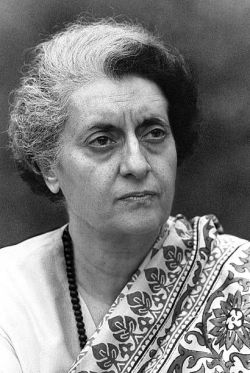Indira Gandhi: Difference between revisions
m Protected "Indira Gandhi" ([Edit=Allow only administrators] (indefinite) [Move=Allow only administrators] (indefinite)) |
No edit summary |
||
| Line 6: | Line 6: | ||
}} | }} | ||
{{Infobox deceased | {{Infobox deceased | ||
| name = Indira Gandhi | | name = Indira Gandhi | ||
| image = Indira Gandhi.jpg | | image = Indira Gandhi.jpg | ||
| image_caption = Indira Gandhi in 1966 | | image_caption = Indira Gandhi in 1966 | ||
Latest revision as of 08:34, 28 June 2025
| Indira Gandhi | |
|---|---|

| |
| Indira Gandhi in 1966 | |
| Born | 19 November 1917 |
| Birthplace | Allahabad, United Provinces, British India (now Uttar Pradesh, India) |
| Died | 31 October 1984 (aged 66) |
| Place of death | New Delhi, India |
| Resting place | Shakti Sthal, New Delhi |
| Nationality | Indian |
| Occupation | Politician, Prime Minister of India |
| Years active | 1947–1984 |
| Known for | First woman Prime Minister of India, Emergency (India), Green Revolution in India |
| Notable works | Leadership in 1971 Indo-Pak War, Emergency (1975–77), Operation Blue Star |
| Awards | Bharat Ratna (1971), Lenin Peace Prize (1983) |
| Spouse(s) | Feroze Gandhi |
| Children | Rajiv Gandhi, Sanjay Gandhi |
| Parents | Jawaharlal Nehru (father), Kamala Nehru (mother) |
| Religion | Hinduism |
| Website | |
Indira Priyadarshini Gandhi (19 November 1917 – 31 October 1984) was the first and, to date, the only female Prime Minister of India. She served as the head of government for three consecutive terms from 1966 to 1977 and a fourth term from 1980 until her assassination in 1984.[1] She was known for her centralizing policies, decisive leadership, and controversial use of emergency powers.
Early Life and Education
Indira Gandhi was born in Allahabad to Jawaharlal Nehru, India's first Prime Minister, and Kamala Nehru. She studied at Visva-Bharati University in India, and later at Somerville College, Oxford in the UK.[2]
Entry into Politics
After India's independence in 1947, she assisted her father in his official duties. She became the President of the Indian National Congress in 1959 and was appointed Minister of Information and Broadcasting under Prime Minister Lal Bahadur Shastri.[3]
Prime Ministership
She became Prime Minister in 1966 following Shastri’s sudden death. Her major initiatives included:
- Nationalization of banks and coal mines
- Promotion of the Green Revolution in India, improving agricultural productivity
- Leading India to victory in the Indo-Pakistani War of 1971, resulting in the creation of Bangladesh
The Emergency (1975–77)
Facing internal unrest and a court verdict invalidating her 1971 election, Indira Gandhi declared a national Emergency in 1975. Civil liberties were curtailed, political opposition was jailed, and press censorship was imposed.[4] This period remains one of the most debated aspects of her legacy.
Return and Assassination
She returned to power in 1980. In 1984, Operation Blue Star was ordered to remove militants from the Golden Temple in Amritsar, which led to criticism among Sikh communities. On 31 October 1984, she was assassinated by her Sikh bodyguards in retaliation.[5]
Legacy
Indira Gandhi remains a polarizing figure—praised for her bold leadership and criticized for authoritarian tendencies. Her legacy is closely tied to the empowerment of women in politics and India’s geopolitical strength during the Cold War era.

